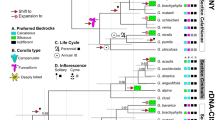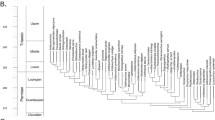Abstract
Phylogeography – the study of within-species phylogenetic and geographic divergence – has been primarily the domain of molecular evolutionists because molecular markers record population structure on smaller scales than do traditional morphological traits. But when geometric morphometrics are combined with distance-based phylogenetics molar shape divergence appears to record population-level phylogeny, a fact that allows extant and fossil populations to be combined in a single phylogeographic study. The European Sorex araneus complex – a genetically complicated group composed of multiple karyotypic races and species – illustrates the principle. The phylogeographic patterns revealed by molar shape broadly agree with scenarios based on molecular data and circumstantial evidence. Importantly, the inclusion of fossil samples of known age allows minimum divergence times to be inferred. Some races of S. araneus may have diverged more than 120,000 years ago, but others may have diverged less than 14,000. Supporting evidence that molar shape can be used to reconstruct phylogeographic relationships comes from strong correlations between molar shape distances and both phylogenetic divergence time and cytochrome b sequence divergence in datasets where these variables are known independently (fossil carnivorans from a well-constrained stratigraphic setting and shrew species of the genus Sorex, respectively). However, molar shape may have a ‘saturation point’ beyond which it is not applicable.
Similar content being viewed by others
References
Avise, J.C., 1994. Molecular Markers, Natural History, and Evolution. Chapman and Hall, New York.
Avise, J.C., 2000. Phylogeography. Harvard University Press, Cambridge, Massachusetts.
Bader, R.S., 1965. Heritability of dental characters in the house mouse. Evolution 19: 378–384.
Bailey R.C. & J. Byrnes, 1990. A new, old method for assessing measurement error in both univariate and multivariate morphometric studies. System. Zool. 39: 124–130.
Balloux, F., H. Brünner, N. Lugon-Moulin, J. Hausser & J. Goudet, 2000. Microsatellites can be misleading: an empirical and simulation study. Evolution 54: 1414–1422.
Barnosky, A.D., 1993. Mosaic evolution at the population level in Microtus pennsylvanicus, pp. 24–59 in Morphological Changes in Quaternary Mammals of North America, edited by R.A. Martin & A.D. Barnosky. Cambridge University Press, Cambridge.
Barton, N.H. & G.M. Hewitt, 1985. Analysis of hybrid zones. Ann. Rev. Ecol. System. 16: 113–148.
Bell, M.A., J.V. Baumgartner & E.C. Olson, 1985. Patterns of temporal change in single morphological characters of a Miocene stickleback fish. Paleobiology 11: 258–271.
Bengtsson, B.O. & I. Frykman, 1990. Karyotype evolution: evidence from the common shrew (Sorex araneus L.). J. Evol. Biol. 3: 85–101.
Berg, H.C., 1993. Random Walks in Biology. Princeton University Press, Princeton, Expanded edn.
Berry, R.J., 1977. Inheritance and Natural History. Collins, London.
Bookstein, F.L., 1992. Morphometric Tools for Landmark Data: Geometry and Biology. Oxford University Press, Oxford.
Churchfield, S.J., 1990. The Natural History of Shrews. Helm, London.
Drummond, A. & A.G. Rodrigo, 2000. Reconstructing genealogies of serial samples under the assumption of a molecular clock using serial sample UPGMA. Mol. Biol. Evol. 17: 1807–1815.
Fedyk, S., 1986. Genetic differentiation of Polish populations of Sorex araneus L. II: possibilities of gene flow between chromosome races. Bull. Polish Acad. Sci. Ser. Biol. 34: 161–172.
Felsenstein, J., 1973. Maximum-likelihood estimation of evolutionary trees from continuous characters. Am. J. Hum. Genet. 25: 471–492.
Fitch, W.M. & E. Margoliash, 1967. Construction of phylogenetic trees. Science 155: 279–284.
Ford, C.E., J.L. Hamerton & G.B. Sharman, 1957. Chromosome polymorphism in the common shrew. Nature 180: 392–393.
Ford, C.E. & J.L. Hamerton, 1970. Chromosome polymorphism in the Common Shrew, Sorex araneus. Symp. Zool. Soc. London 26: 223–236.
Fumagalli, L., J. Hausser, P. Taberlet, L. Gielly & D.T. Stewart, 1996. Phylogenetic structures of the Holarctic Sorex araneus group and its relationships with S. samniticus, as inferred from mitochondrial DNA sequences. Hereditas 125: 191–199.
Fumagalli, L., P. Taberlet, D.T. Stewart, L. Gielly, J. Hausser & P. Vogel, 1999. Molecular phylogeny and evolution of Sorex shrews (Soricidae: Insectivora) inferred from mitochondrial DNA sequence data. Mol. Phylogenet. Evol. 11: 222–235.
Gingerich, P.D., 1974. Size variability of teeth in living mammals and the diagnosis of closely related sympatric fossil species. J. Paleontol. 48: 895–903.
Gingerich, P.D., 1993. Quantification and comparison of evolutionary rates. Am. J. Sci. 293–A: 453–478.
Gingerich, P.D., 2001. Rates of evolution on the time scale of the evolutionary process. Genetica 112-113: 127–144.
Graham, R.W., E.L. Lundelius, M.A. Graham, E.K. Schroeder, R.S. Toomey, E. Anderson, A.D. Barnosky, J.A. Burns, C.S. Churcher, D.K. Grayson, R.D. Guthrie, C.R. Harington, G.T. Jefferson, L.D. Martin, H.G. McDonald, R.E. Morlan, H.A. Semken, S.D. Webb, L. Werdelin, L. & M.C. Wilson, 1996. Spatial response of mammals to late quaternary environmental fluctuations. Science 272: 1601–1606.
Hausser, J., 1994. The Sorex of the araneus-arcticus group (Mammalia: Soricidae): do they actually speciate? Carnegie Museum Natur. Hist. Spl. Publ. 18: 295–306.
Hausser, J., F. Catzeflis, A. Meylan & P. Vogel, 1985. Speciation in the Sorex araneus complex (Mammalia, Insectivora). Acta Zool. Fenn. 170: 125–130.
Hausser, J., L. Fumagalli & P. Taberlet, 1998. Mitochondrial DNA evolution in shrews, pp. 295–308 in Evolution of Shrews, edited by J.M. Wójcik & M. Wolsan. Mammal Research Institute, Polish Academy of Sciences, Bialowieza.
Hausser, J. & D. Jammot, 1974. Etude biométrique des mâchoires chez les Sorex du groupe araneus en Europe continentale (Mammalia, Insectivora). Mammalia 38: 324–343
Hewitt, G.M., 1996. Some genetic consequences of ice ages, and their role in divergence and speciation. Biol. J. Linn. Soc. 58: 247–276.
Hewitt, G.M., 1999. Post-glacial re-colonization of European biota. Biol. J. Linn. Soc. 68: 87–112.
Jernvall, J., 1995. Mammalian molar cusp patterns: developmental mechanisms of diversity. Acta Zool. Fenn. 198: 1–61.
Johnson, N.A. & A.H. Porter, 2001. Toward a new synthesis: population genetics and evolutionary developmental biology. Genetica 112-113: 45–58.
Keränen, S.V.E., T. Åberg, P. Kettunen, I. Thesleff, I. & J. Jernvall, 1998. Association of developmental regulatory genes with the development of different molar shapes in two species of rodent. Develop. Genes Evol. 208: 477–486.
Kinnison, M.T. & A.P. Hendry, 2001. The pace of modern life. II: from rates to pattern and process. Genetica 112-113: 145–164.
Lister, A., 1995. Sea-levels and the evolution of island endemics: the dwarf red deer of Jersey. Geol. Soc. Spl. Publ. 96: 151–172.
MacLeod N. & K.D. Rose, 1993. Inferring locomotor behavior in paleogene mammals via eigenshape analysis. Am. J. Sci. 293–A: 300–355.
Manly, B.F.J., 1986. Randomization and regression methods for testing for associations with geographical, environmental and biological distances between populations. Res. Populat. Ecol. 28: 201–281.
Martin, R.A., 1993. Patterns of variation and speciation in quaternary rodents, pp. 226–280 in Morphological Change in Quaternary Mammals of North America, edited by R.A. Martin & A.D. Barnosky. Cambridge University Press, Cambridge, England.
Mercer, S.J. & J.B. Searle, 1991. Preliminary analysis of a contact zone between karyotypic races of the common shrew (Sorex araneus) in Scotland. Mémoir. Soc. Vaud. Sci. Naturell. 19: 73–78.
Mercer, S.J., J.B. Searle & B.M.N. Wallace, 1991. Meiotic studies of karyotypically homogenous and heterozygous male common shrews. Mémoir. Soci. Vaud. Sci. Naturell. 19: 33–43.
Mousseau, T.A. & D.A. Roff, 1986. Natural selection and the heritability of fitness components. Heredity 59: 181–197.
Neet C. & J. Hausser, 1989. Chromosomal rearrangements, speciation and reproductive isolation: the example of two karyotypic species of the genus Sorex. J. Evol. Biol. 2: 373–378.
Novacek, M.J., 1992. Mammalian phylogeny: shaking the tree. Nature 356: 121–125.
Ohdachi, S., R. Masuda, H. Abe, J. Adachi, N.E. Dokuchaev, V. Haukisalmi & M.C. Yoshida, 1997. Phylogeny of Eurasian soricine shrews (Insectivora, Mammalia) inferred from the mitochondrial cytochrome b gene sequences. Zool. Sci. 14: 527–532.
Patton, J.L. & M.F. Smith, 1989. Population structure and the genetic and morphological divergence among pocket gopher species (genus Thomomys), pp. 284–304 in Speciation and its Consequences, edited by D. Otte & J.A. Endler. Sinauer, Sunderland, Massachusetts.
Pergams, O.R.W. & M.V. Ashley, 2001. Microevolution in island rodents. Genetica 112-113: 245–256.
Polly, P.D., 1997. Ancestry and species definition in paleontology: a stratocladistic analysis of Viverravidae (Carnivora, Mammalia) from Wyoming. Contributions from the Museum of Paleontology, University of Michigan 30: 1–53.
Polly, P.D., 1998. Variability, selection, and constraints: development and evolution in viverravid (Carnivora, Mammalia) molar morphology. Paleobiology 24: 409–429.
Polly, P.D., 2001. Phylogenetic Tests for Differences in Shape and the Importance of Divergence Times: Eldredge' Enigma Explored, in Morphology, Shape, and Phylogenetics, edited by N. MacLeod & P. Forey. Taylor and Francis, London.
Prager, E.M. & A.C. Wilson, 1978. Construction of phylogenetic trees for proteins and nucleic acids: empirical evaluation of alternative matrix methods. J. Mol. Evol. 11: 129–142.
Rambaut, A., 2000. Estimating the rate of molecular evolution: incorporating non-contemporaneous sequences into maximum likelihood phylogenies. Bioinformatics 16: 395–399.
Repenning, C.A., 1967. Subfamilies and genera of the Soricidae. U.S. Geol. Surv. Profess. Paper 565: 1–74.
Rohlf, F.J., 1998. tpsSmall: Is shape variation small? Department of Ecology and Evolution, State University of New York at Stony Brook, Stony Brook, New York.
Rohlf, F.J., 1999. Shape statistics: Procrustes superimpositions and tangent spaces. J. Classif. 16: 197–223.
Searle, J.B., 1984. Three new karyotypic races of the common shrew Sorex araneus (Mammalia: Insectivora) and a phylogeny. Systemat. Zool. 33: 184–194.
Searle, J.B., 1986. Meiotic studies of Robertsonian heterozygotes from natural populations of the common shrew, Sorex araneus L. Cytogenet. Cell Genet. 41: 154–162.
Searle, J.B. & P.J. Wilkinson, 1987. Karyotypic variation in the common shrew (Sorex araneus) in Britain - a ‘Celtic Fringe’. Heredity 59: 345–351.
Searle, J.B. & J.M. Wójcik, 1998. Chromosomal evolution: the case of Sorex araneus, pp. 217–268 in Evolution of Shrews, edited by J.M. Wójcik & M. Wolsan. Mammal Research Institute, Polish Academy of Sciences, Bialowieza.
Sneath, P.H.A. & R.R. Sokal, 1973. Numerical Taxonomy. W.H. Freeman and Co., San Francisco.
Thorpe, R.S., 1996. The use of DNA divergence to help determine the correlates of evolution of morphological characters. Evolution 50: 524–531.
Thorpe, R.S., A. Malhotra, H. Black, J.C. Daltry & W. Wüster, 1995. Relating geographic pattern to phylogenetic process. Philos. Transact. Royal Soc. London Ser. B 349: 61–68.
Yalden, D.W., 1982. When did the mammal fauna of the British Isles arrive? Mamm. Rev. 12: 1–57.
Ziegler, R., 1995. Pleistozäne Säugetierfaunen von Genkingen bei Reutlingen (Baden-Württemberg). Stutt. Beit. Naturk. Ser. B, 234: 1–43.
Zima, J., S. Fedyk, K. Fredga, J. Hausser, A. Mishta, J.B. Searle, V.T. Volobouev & J.M. Wójcik, 1996. The list of the chromosome races of the common shrew (Sorex araneus). Hereditas 125: 97–107.
Author information
Authors and Affiliations
Rights and permissions
About this article
Cite this article
Polly, P.D. On morphological clocks and paleophylogeography: towards a timescale for Sorex hybrid zones. Genetica 112, 339–357 (2001). https://doi.org/10.1023/A:1013395907225
Issue Date:
DOI: https://doi.org/10.1023/A:1013395907225




